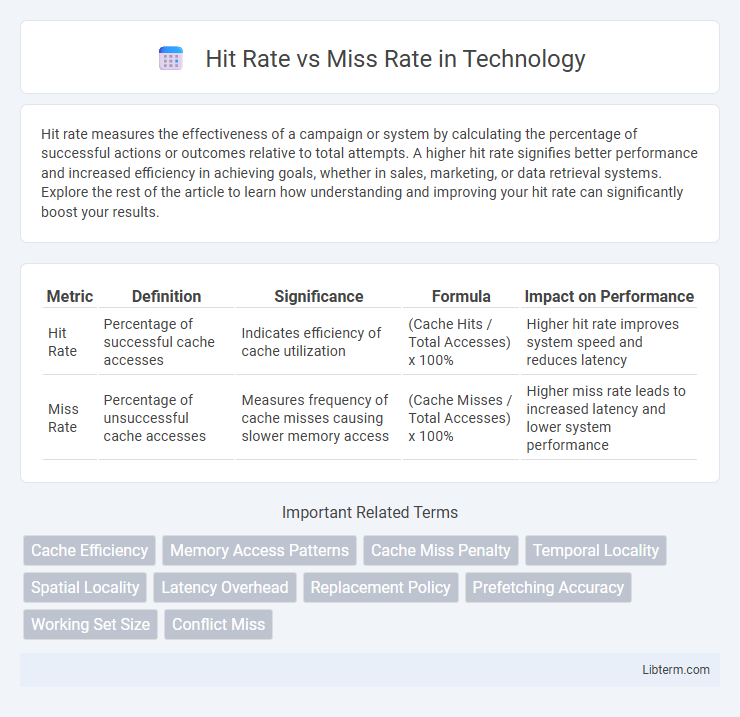Hit rate measures the effectiveness of a campaign or system by calculating the percentage of successful actions or outcomes relative to total attempts. A higher hit rate signifies better performance and increased efficiency in achieving goals, whether in sales, marketing, or data retrieval systems. Explore the rest of the article to learn how understanding and improving your hit rate can significantly boost your results.
Table of Comparison
| Metric | Definition | Significance | Formula | Impact on Performance |
|---|---|---|---|---|
| Hit Rate | Percentage of successful cache accesses | Indicates efficiency of cache utilization | (Cache Hits / Total Accesses) x 100% | Higher hit rate improves system speed and reduces latency |
| Miss Rate | Percentage of unsuccessful cache accesses | Measures frequency of cache misses causing slower memory access | (Cache Misses / Total Accesses) x 100% | Higher miss rate leads to increased latency and lower system performance |
Understanding Hit Rate and Miss Rate
Hit rate measures the proportion of successful cache accesses where the requested data is found, directly impacting system performance by reducing memory access time. Miss rate represents the frequency of cache misses, requiring data retrieval from slower memory and increasing latency. Optimizing cache strategies aims to maximize hit rate while minimizing miss rate to enhance overall computing efficiency.
Importance of Measuring Hit Rate and Miss Rate
Measuring hit rate and miss rate is crucial for evaluating the efficiency of cache memory and optimizing system performance. High hit rates indicate effective data retrieval with minimal latency, while miss rates highlight areas needing improvement or additional resource allocation. Monitoring these metrics enables informed decisions to enhance computational speed and reduce processing delays.
Hit Rate Definition and Calculation
Hit Rate measures the proportion of successful data retrievals from a cache or memory compared to total access attempts, reflecting system efficiency. It is calculated by dividing the number of cache hits by the sum of cache hits and cache misses (Hit Rate = Hits / (Hits + Misses)). A higher Hit Rate indicates better performance, as more requests are served directly from the faster cache memory.
Miss Rate Definition and Calculation
Miss Rate represents the proportion of times a system fails to correctly identify or retrieve relevant items, indicating the frequency of missed opportunities in data retrieval or classification tasks. It is calculated by dividing the number of missed relevant instances by the total number of relevant instances, expressed as Miss Rate = Misses / (Hits + Misses). This metric is critical in evaluating the performance and accuracy of caching systems, search engines, and machine learning classifiers.
Key Differences Between Hit Rate and Miss Rate
Hit Rate measures the proportion of successful cache accesses, reflecting the efficiency of memory utilization by indicating how often requested data is found. Miss Rate, conversely, quantifies the frequency of cache misses, highlighting the percentage of access attempts that require fetching data from slower memory tiers. The key difference lies in their complementary nature: Hit Rate represents successful retrievals, while Miss Rate indicates failures, with both metrics summing to 100% for a given workload.
Real-World Applications of Hit and Miss Rates
Hit rate measures the frequency of successful outcomes, while miss rate quantifies failures in various systems such as cache memory, spam filters, and recommendation engines. High hit rates optimize system efficiency by reducing retrieval time and resource consumption, whereas elevated miss rates often signal the need for algorithm refinement or data quality improvements. In real-world applications, balancing hit and miss rates is crucial for enhancing user experience and operational performance across domains like cybersecurity, e-commerce, and network management.
Factors Influencing Hit and Miss Rates
Cache size, block size, and replacement policies significantly impact hit and miss rates in memory systems. Larger cache sizes and optimal block sizes tend to increase hit rates by storing more relevant data and reducing compulsory misses. Effective replacement algorithms, such as Least Recently Used (LRU), minimize miss rates by retaining frequently accessed data and evicting less useful blocks.
Strategies to Improve Hit Rate
Improving hit rate in caching systems involves optimizing data retrieval strategies such as implementing efficient caching algorithms like Least Recently Used (LRU) or Adaptive Replacement Cache (ARC). Increasing cache size and prefetching frequently accessed data based on usage patterns also enhances hit rate. Monitoring and analyzing access logs enable fine-tuning of cache policies, reducing miss rate and improving overall system performance.
Impact of Miss Rate on System Performance
Miss rate directly impacts system performance by increasing memory access latency, leading to more CPU stalls and reduced throughput. Higher miss rates cause frequent accesses to slower main memory, significantly degrading overall execution speed. Optimizing cache design and replacement policies is crucial to minimize miss rate and enhance computational efficiency.
Hit Rate vs Miss Rate: Best Practices for Analysis
Hit rate and miss rate are critical metrics for evaluating system performance, especially in caching and information retrieval contexts, with hit rate measuring successful data retrieval and miss rate indicating failures to retrieve requested data. Best practices for analysis involve consistently tracking both rates to identify patterns, optimizing system response strategies, and balancing resource allocation for improved efficiency. Employing tools such as confusion matrices and ROC curves further refines the understanding of hit and miss rates for precise decision-making.
Hit Rate Infographic

 libterm.com
libterm.com